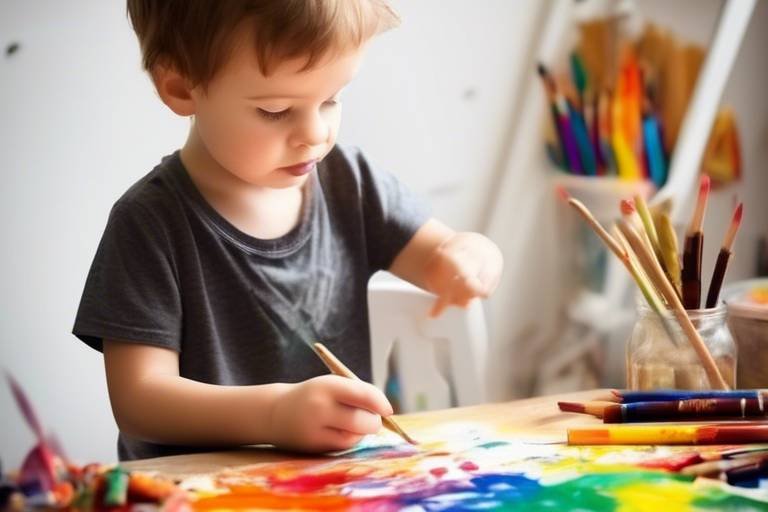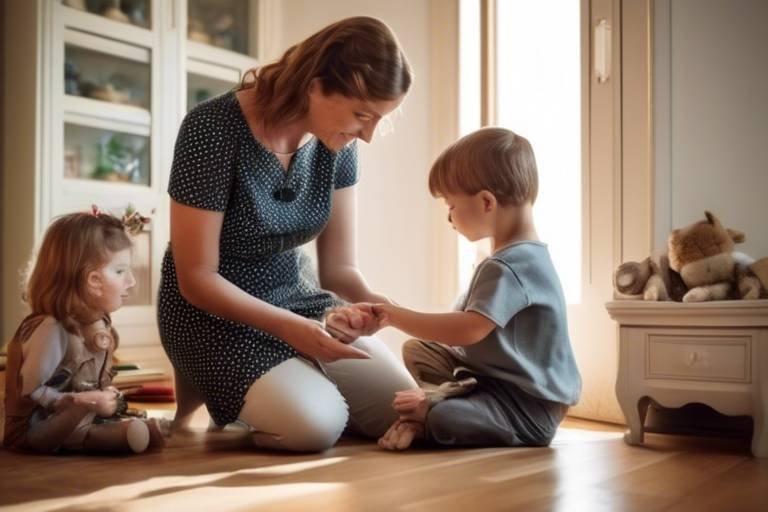Supporting Your Child's Artistic Passions: Fostering Creativity at Home
Every child is a born artist, but sometimes, they just need a little push to unleash their creative potential. As parents, it’s our responsibility to cultivate this passion. Fostering creativity at home is not just about providing supplies; it's about creating an environment that inspires and encourages self-expression. Imagine your living room transformed into a vibrant art studio! Sounds exciting, right? By embracing your child's artistic interests, you can help them discover their unique voice and build confidence in their abilities. In this article, we’ll explore various strategies to nurture your child’s artistic passions, from understanding their interests to celebrating their achievements.
Recognizing your child's unique artistic inclinations is vital. The first step is to observe what naturally draws their attention. Do they love drawing, painting, or perhaps crafting? Encourage them to explore different mediums and styles. You might ask questions like, “What colors do you like the most?” or “What do you enjoy creating the most?” This not only helps you understand their preferences but also opens up avenues for deeper conversations about art. Encouraging exploration can lead to delightful surprises, revealing talents you never knew they had!
An inviting art space can significantly enhance creativity. Think of it as a sanctuary where your child can freely express themselves without fear of judgment. Choose a corner in your home that's filled with natural light and add personal touches that resonate with your child's personality. This could be a cozy nook with cushions, a small table for their projects, or even a wall where they can display their masterpieces. The goal is to create a space that feels safe and inspiring. When they walk into this area, it should spark joy and creativity, making them eager to dive into their artistic endeavors.
Having the right tools is crucial for artistic exploration. Here’s a quick rundown of essential supplies that can inspire creativity in your child:
- Colored pencils and markers
- Watercolors and brushes
- Sketchbooks and canvases
- Glue, scissors, and craft paper
- Recyclable materials for collage
These items not only provide a foundation for various art projects but also encourage experimentation. Let your child choose their favorite colors and materials, making the process even more engaging!
Art supplies don’t have to be expensive. You can find budget-friendly options at local dollar stores or even online. Consider repurposing items around the house, like old magazines for collages or leftover fabric for textile art. The key is to think creatively about materials. Inspiration can come from the most unexpected places!
Keeping art supplies organized can help maintain a creative flow. Use bins, baskets, or even a dedicated drawer to store materials. Labeling containers can make it easier for your child to find what they need, fostering independence and responsibility. A well-organized space not only saves time but also keeps the creative juices flowing smoothly, allowing your child to focus on what truly matters—creating art!
Encouragement is key to fostering creativity. Motivate your child to try new techniques and explore different artistic mediums. You might set up themed art days, where each session focuses on a different style, such as abstract painting or clay modeling. Ask open-ended questions like, “What would happen if you mixed these two colors?” or “How does this texture feel?” This not only stimulates their imagination but also invites them to think critically about their work.
Integrating art into everyday activities can enhance creativity. Why not make art a part of your family’s routine? You could have a weekly art night where everyone creates something together. It’s a fantastic way to bond and explore different artistic expressions. Also, consider turning mundane tasks into creative opportunities, like decorating the dinner table with handmade place cards or creating a family mural on a large piece of paper.
Family activities centered around art can strengthen bonds and inspire creativity. Here are a few ideas for collaborative art projects:
- Create a family scrapbook
- Design a mural together
- Host a mini art exhibition at home
These activities not only allow for creativity but also create lasting memories. Plus, they show your child that art can be a shared experience full of laughter and joy.
Technology can be a powerful tool for artistic expression. There are numerous apps and online resources that can enhance your child's creative journey. Programs like Procreate or Adobe Fresco allow for digital painting, while platforms like YouTube offer countless tutorials on various art techniques. Encourage your child to explore these resources, blending traditional art with digital creativity. It’s like having an art class right at their fingertips!
Recognizing and celebrating your child's artistic accomplishments can boost their confidence. Whether it’s displaying their artwork on the fridge, creating a gallery wall in their room, or even hosting a family art show, these gestures convey how much you value their creativity. Remember, every piece of art, no matter how small, is a step towards building their artistic identity. Celebrate the journey, not just the end result!
1. How can I encourage my child if they feel discouraged about their art?
It's essential to remind them that art is subjective and that every artist has their unique style. Encourage them to express their feelings through their art and reassure them that practice makes perfect.
2. What if my child shows interest in multiple art forms?
Embrace this interest! Allow them to explore various mediums and styles. This exploration will help them discover what they truly love and develop a more well-rounded artistic skill set.
3. How do I handle messiness during art projects?
Mess is part of the creative process! Set up a designated art area that’s easy to clean and use old newspapers or drop cloths to protect surfaces. Teach your child to clean up after their projects, making it a part of the creative routine.

Understanding Your Child's Interests
Recognizing your child's unique artistic inclinations is vital to nurturing their creativity. Every child has their own preferences and styles, which can often be seen in the way they express themselves through various art forms. Have you ever noticed how your little one gravitates towards certain colors or materials? Perhaps they spend hours doodling in their sketchbook or enthusiastically mixing paints? These are all signs of their artistic interests waiting to be explored!
To truly understand what captivates your child's imagination, take the time to observe their behavior and choices. For instance, do they enjoy painting, drawing, sculpting, or maybe even digital art? Engaging them in conversations about their favorite activities can provide valuable insights. Ask open-ended questions like, "What do you enjoy most about drawing?" or "If you could create anything, what would it be?" This not only fosters communication but also encourages them to articulate their passions.
Additionally, consider introducing them to a variety of art forms. You might be surprised by what they take a liking to! For example, you could explore:
- Painting: Watercolors, acrylics, or even finger painting can unleash vibrant creativity.
- Drawing: Sketching with pencils, markers, or charcoal can help develop their skills.
- Crafting: Collage-making, sculpting with clay, or DIY projects can be incredibly fulfilling.
- Digital Art: Using tablets or computers can introduce them to a modern form of artistic expression.
Encouraging your child to try different mediums not only broadens their artistic horizons but also helps you identify what truly resonates with them. Remember, the goal is to create a supportive environment where they feel free to explore and experiment without fear of judgment. Celebrate their efforts, regardless of the outcome, and provide positive reinforcement. This will instill confidence in their abilities and encourage them to continue pursuing their artistic passions.
In conclusion, understanding your child's artistic interests involves a combination of observation, conversation, and exploration. By actively engaging with them and providing opportunities to experiment with different art forms, you can help them discover their true creative voice. So, are you ready to embark on this colorful journey together?

Creating an Inspiring Art Space
Creating an inspiring art space at home is like setting the stage for a spectacular performance; it invites creativity and encourages your child to express themselves freely. The environment plays a crucial role in nurturing artistic talents, and a well-organized, inviting space can make all the difference. Imagine walking into a room filled with vibrant colors, textures, and tools just waiting to be used—this is the kind of atmosphere that can spark imagination and fuel artistic exploration.
To begin with, consider the location of your art space. It doesn't have to be a dedicated room; even a corner of the living room or a section of the dining table can work wonders. The key is to choose a spot that is well-lit and comfortable. Natural light is particularly beneficial, as it not only illuminates the area but also lifts spirits. If possible, set up near a window where your child can gaze outside for inspiration. Having a view of nature or the neighborhood can ignite creativity, allowing them to draw from the world around them.
Next, think about the layout of the space. An inspiring art area should be organized yet flexible, allowing your child to experiment without feeling constrained. Use tables or desks that are the right height for your child, and ensure there is ample space for them to spread out their materials. You might even consider a large easel for painting or drawing, which can add a professional touch to their creative endeavors. Make sure to include comfortable seating options, as your child may spend hours immersed in their artwork.
When it comes to decorating the space, let your child take the lead. Encourage them to personalize their area with their own artwork, posters of their favorite artists, or even inspirational quotes that resonate with them. This sense of ownership can motivate them to spend more time in their art space. Additionally, consider adding elements that stimulate the senses—soft music playing in the background or a scented candle can create a calming atmosphere conducive to creativity.
In terms of organization, having a dedicated storage solution for art supplies is essential. Use shelves, bins, or carts to keep materials accessible yet tidy. You can categorize supplies by type (paints, brushes, paper) or by project, ensuring everything is easy to find. A simple table like the one below can help visualize how to organize art supplies:
| Category | Examples |
|---|---|
| Painting | Watercolors, acrylics, paintbrushes |
| Drawing | Pencils, markers, sketch pads |
| Crafting | Glue, scissors, colored paper |
| Mixed Media | Collage materials, fabric, beads |
Finally, don’t forget to include a space for cleanup! Having a designated area with wipes, aprons, and trash bins can help keep the space tidy and encourage your child to take care of their materials. Remember, creativity can be messy, and that’s part of the fun! By providing the right environment, you’re not just giving your child a place to create; you’re giving them the freedom to explore their artistic passions without limits.
- What if my child doesn't know what art supplies to use? Start with basic supplies like colored pencils, watercolor paints, and sketch paper. Let them experiment and discover what they enjoy most.
- How can I motivate my child if they feel stuck? Encourage them to take breaks, explore new mediums, or look at other artists' work for inspiration. Sometimes a change of scenery can spark new ideas!
- Is it necessary to have a separate art space? Not necessarily! A designated area is helpful, but any space where your child feels comfortable and inspired can work just as well.

Essential Art Supplies
When it comes to nurturing your child's artistic talents, having the right tools can make a world of difference. Think of art supplies as the paintbrushes of creativity; without them, your child's imagination might struggle to come to life. So, what are the essential art supplies that can inspire your little artist? Let’s dive into some must-haves that can help your child explore their creativity.
First and foremost, paper is the foundation of any artistic endeavor. Whether it’s sketching, painting, or collaging, different types of paper can open up a world of possibilities. For instance, you might want to stock up on:
- Sketch paper for quick doodles and ideas
- Watercolor paper for those beautiful, fluid paintings
- Cardstock for sturdy projects and crafts
Next up are drawing tools. Pencils, markers, and crayons are just the tip of the iceberg. Consider introducing your child to a variety of mediums:
- Colored pencils for detailed work
- Pastels for vibrant, soft textures
- Charcoal for dramatic shading and depth
But what about color? Paints are essential for any budding artist. You might want to explore:
- Acrylic paints for their versatility and quick drying time
- Watercolors for delicate washes and blending
- Tempera paints for easy clean-up and vibrant colors
Additionally, don't forget about brushes! A variety of sizes and shapes can help your child experiment with different techniques. Think about including:
- Flat brushes for broad strokes
- Round brushes for detailed work
- Sponge brushes for unique textures
Lastly, a palette is essential for mixing colors, and a few canvas boards can elevate their painting experience. Having a dedicated space for art supplies not only keeps things organized but also makes it easier for your child to dive into their creative projects without the hassle of searching for materials.
In summary, equipping your child with a variety of essential art supplies can significantly enhance their creative journey. Think of these supplies as the building blocks of their artistic expression, allowing them to explore, experiment, and ultimately, discover their unique style. Remember, the goal isn’t to create a masterpiece every time but to enjoy the process of creating!

Budget-Friendly Options
When it comes to nurturing your child's artistic passions, can make all the difference. You don't need to spend a fortune on art supplies to foster creativity. In fact, some of the most inspiring materials can be found right in your home or at local thrift stores! Think of it this way: creativity often flourishes in the face of limitations. By using affordable materials, you can teach your child to see art everywhere, turning ordinary objects into extraordinary masterpieces.
Start by exploring your home for items that can be repurposed into art supplies. Old magazines, newspapers, and scrap paper can serve as fantastic collage materials. Empty toilet paper rolls and egg cartons can become the building blocks of imaginative sculptures. In this way, you not only save money but also encourage your child to think outside the box. Creativity is about resourcefulness!
Additionally, consider visiting local thrift shops or dollar stores. These places often have hidden gems—think of paint, brushes, and canvases at a fraction of the cost. You might even stumble upon unique items that can spark new ideas. For instance, a vintage book could be transformed into a stunning art journal. Remember, the goal is to provide your child with the freedom to explore without the pressure of expensive materials.
Another fantastic option is to organize art supply swaps with friends or family. Gather your children's unused or gently used art supplies and trade them for something new. This not only keeps costs down but also promotes a sense of community and sharing. If you’re feeling particularly crafty, you can even host a DIY art supply creation day where everyone brings in items to make new art tools together. The possibilities are endless!
To help visualize these ideas, here’s a simple table that outlines some common household items that can be transformed into art supplies:
| Household Item | Art Supply Use |
|---|---|
| Old Magazines | Collage materials |
| Cardboard Boxes | 3D sculptures |
| Egg Cartons | Paint palettes or sculpture bases |
| Fabric Scraps | Textile art or mixed media projects |
| Plastic Containers | Storage for art supplies |
In summary, fostering your child's artistic talents doesn't have to be expensive. By using everyday items creatively, shopping smart, and encouraging resourcefulness, you're not only saving money but also teaching valuable lessons about creativity and sustainability. So, roll up those sleeves, get messy, and watch your child's imagination soar without breaking the bank!
1. What are some inexpensive art supplies I can start with?
You can start with basic items like paper, crayons, markers, and glue. Look for items around your home, such as cardboard, old magazines, and fabric scraps.
2. How can I encourage my child to be creative without spending a lot of money?
Encourage your child to use recycled materials for their projects. Organize art supply swaps with friends and visit thrift stores for unique finds.
3. What if my child doesn't know what to create?
Inspire them by suggesting themes or challenges, such as creating art from nature or making something that represents their favorite story.
4. Are there free resources for art projects online?
Yes! There are many websites and YouTube channels that offer free art tutorials and project ideas, making it easy to find inspiration without spending a dime.

Organizing Art Supplies
Keeping art supplies organized is essential for maintaining a creative flow in your home. Imagine your child bursting with inspiration, only to be thwarted by a chaotic mess of crayons, paint tubes, and brushes scattered everywhere. To prevent this, creating a structured system for organizing art materials is key. Start by categorizing supplies into different groups: drawing materials, painting tools, crafting items, and miscellaneous supplies. This way, when your little artist feels the urge to create, they can easily find what they need without the frustration of searching through a disorganized pile.
One effective method is to use clear containers or bins. Not only do they keep supplies visible and accessible, but they also add a touch of order to the art space. For example, you might have a bin for markers, another for colored pencils, and yet another for paints. Labeling each container can further simplify the process, allowing your child to quickly identify where everything belongs. This approach not only teaches them the importance of organization but also encourages responsibility for their own materials.
Another great idea is to utilize vertical storage solutions, such as pegboards or wall-mounted shelves. These options not only save space but also turn your art area into an inspiring visual display. Imagine a colorful array of paints hanging neatly on a pegboard, ready to spark creativity at a moment's notice. Plus, this method keeps supplies off surfaces, allowing for a more spacious and inviting workspace.
For smaller items like beads, stickers, or stamps, consider using a tackle box or a small drawer unit with dividers. This way, everything has its designated spot, and your child can easily see their options. Regularly involving your child in the organization process can also be a fun activity. Turn it into a game where they can sort items by color, size, or type, making it a creative task in itself!
Ultimately, the goal is to create an environment that fosters creativity and makes it easy for your child to dive into their artistic projects. By implementing these organization strategies, you’re not just tidying up; you’re paving the way for your child to thrive in their artistic pursuits. Remember, a well-organized art space can be as inspiring as the art itself!
Q: What are some budget-friendly ways to organize art supplies?
A: You can use recycled containers such as jars, boxes, or even old shoe organizers. These can be creatively repurposed to store various art materials without spending much.
Q: How often should I reorganize the art supplies?
A: It's a good idea to reassess the organization every few months or whenever you notice your child struggling to find their supplies. This keeps the space functional and inspiring.
Q: Can I involve my child in the organizing process?
A: Absolutely! Involving your child not only makes them feel responsible but also adds an element of fun. You can turn it into a creative game where they can sort and categorize their supplies.

Encouraging Artistic Exploration
Encouraging your child to explore their artistic side is like opening a door to a world full of possibilities. It’s not just about picking up a paintbrush or molding clay; it’s about fostering a mindset that embraces creativity and experimentation. So, how can you ignite that spark of exploration in your little one? Here are some strategies that can help.
First off, create a supportive environment. Make it clear that it's okay to make mistakes. Think of it this way: every artist, even the greats, has faced failure. Remind your child that each “oops” can lead to unexpected discoveries. If they spill paint, instead of panicking, ask them what colors they see mixing together. This not only encourages them to think creatively but also teaches resilience.
Next, introduce variety into their artistic journey. Offer them a wide range of materials and techniques. From watercolors to charcoal, and from collage to digital art, the more they experiment, the more they’ll find what truly resonates with them. You might even consider setting up a “mystery box” filled with different art supplies and letting them choose what to create with. The thrill of the unknown can be incredibly motivating!
Another great way to encourage exploration is to involve them in community art events. Look for local workshops, art fairs, or exhibitions where they can interact with other budding artists. This exposure not only broadens their horizons but also helps them realize that art is a collaborative and communal experience. Plus, seeing other kids their age creating can be a huge source of inspiration!
Lastly, don’t forget to celebrate their efforts. Whether it’s a simple doodle or a grand painting, acknowledging their creations fosters a sense of pride and accomplishment. You could set up a mini-gallery at home where they can display their artwork. This not only boosts their confidence but also reinforces the idea that their artistic expression is valued.
In conclusion, encouraging artistic exploration is about creating a nurturing space where your child feels free to express themselves without limitations. By providing them with diverse materials, celebrating their creations, and involving them in the community, you’re not just fostering their artistic skills but also nurturing their spirit. Remember, every masterpiece begins with a single stroke, so let your child paint their own journey!

Incorporating Art into Daily Life
Integrating art into your family's daily routine can be a delightful way to enhance creativity and self-expression. Imagine transforming mundane moments into vibrant experiences filled with color and imagination! By weaving artistic activities into everyday life, you not only nurture your child's artistic talents but also create lasting memories together. So, how can you make art a part of your daily grind? Let's explore some engaging ideas!
One of the easiest ways to incorporate art into daily life is to turn ordinary tasks into creative opportunities. For instance, while cooking dinner, why not have your child help with the meal prep by arranging vegetables in fun shapes or creating colorful fruit salads? This not only makes cooking more enjoyable but also allows your child to express their creativity while learning about food. Similarly, during family outings, encourage your child to capture the experience through sketches or photographs. This can turn a simple trip to the park into an artistic adventure!
Another fantastic way to infuse art into daily life is through themed art days. Designate a specific day each week where everyone in the family engages in an artistic activity. Whether it’s painting, crafting, or even digital art, this dedicated time allows your child to look forward to expressing themselves creatively. You can create a family art calendar to keep track of these activities, making it a fun tradition that everyone anticipates. Imagine the joy of sharing your creations at the end of each week!
Additionally, consider using art as a tool for communication. For instance, create a family bulletin board where each member can pin up their artwork, thoughts, or even quotes that inspire them. This not only showcases individual creativity but also fosters a sense of community and belonging within the family. You might find that your child feels more comfortable expressing their feelings and ideas through art, leading to deeper conversations and connections.
Technology can also play a significant role in incorporating art into daily life. There are numerous apps and online platforms that encourage creativity through digital drawing, animation, and design. By allowing your child to explore these resources, you open up a world of artistic possibilities right at their fingertips! Plus, it’s a great way to keep them engaged while learning new skills.
In summary, incorporating art into daily life is not just about setting aside time for painting or drawing; it’s about finding creative moments in the ordinary. Whether through cooking, family activities, or digital exploration, there are countless ways to foster a love for art within your home. So, why not start today? You’ll be amazed at how these small changes can ignite your child’s passion for creativity and strengthen your family bonds!
Q: How can I encourage my child to be more creative?
A: Encourage creativity by providing various art supplies, allowing freedom in artistic expression, and integrating art into everyday activities. Celebrate their efforts and creations to boost their confidence.
Q: What are some budget-friendly art supplies I can use?
A: Look for items around the house like old newspapers, cardboard, or even kitchen utensils. Dollar stores often have a variety of affordable art supplies, including paints, brushes, and paper.
Q: How can technology help in fostering creativity?
A: Technology offers numerous apps for drawing, crafting, and animation that can inspire your child. Online tutorials and classes can also provide new skills and techniques to explore.
Q: What if my child is not interested in traditional art forms?
A: Encourage exploration of various artistic mediums such as digital art, photography, or even performance arts like dance and theater. The key is to find what resonates with them!

Artistic Family Activities
Engaging in is a fantastic way to not only foster creativity but also strengthen the bonds within the family. Imagine a Saturday afternoon where instead of the usual routines, everyone gathers around a table, paintbrushes in hand, ready to unleash their inner Picassos! These moments can become cherished memories, all while nurturing your child's artistic spirit.
One of the most enjoyable activities is to set up a family art night. Each week, you could choose a different theme—perhaps landscapes one week, and abstract art the next. This not only keeps the excitement alive but also allows each family member to explore various styles and techniques. You might be surprised to find that your child is particularly fond of watercolors, while you might discover a hidden talent for charcoal sketches!
Another great way to incorporate art into family time is by creating a collaborative mural. Pick a wall in your home (perhaps a large canvas or a designated wall in the garage) and let each family member contribute their own flair. This could be an ongoing project where everyone adds something new over time. Not only does this beautify your home, but it also serves as a constant reminder of your family's collective creativity.
Don't forget about the power of nature! Organizing an outdoor art day can be both refreshing and inspiring. Grab some canvases, paints, and brushes, and head to a local park or even your backyard. Encourage your child to paint what they see, whether it’s the vibrant colors of flowers or the intricate patterns of tree bark. This experience can teach them to appreciate the beauty of their surroundings while expressing it through art.
Additionally, consider incorporating art challenges into your family activities. Set a timer and see who can create the most imaginative piece in just 30 minutes! This not only adds an element of fun and friendly competition but also encourages quick thinking and improvisation in artistic expression. You can even have a gallery night afterward to showcase everyone's work, complete with snacks and refreshments!
Finally, don’t underestimate the power of storytelling through art. Encourage your child to create a series of illustrations that tell a story. This can be a wonderful way to combine art with literacy and can be done using simple materials like colored pencils or markers. As they illustrate their tale, sit with them and discuss the characters and plot, making it a family storytelling session that enhances both creativity and communication skills.
Incorporating these artistic family activities into your routine not only nurtures your child's love for art but also creates a vibrant, creative atmosphere at home. So, gather those supplies, unleash your creativity, and watch as your family bonds over the joy of artistic expression!
Q: How can I encourage my child to express themselves artistically?
A: Start by providing various art supplies and allowing them to explore different mediums. Encourage them to create freely without the pressure of perfection.
Q: What if my child is hesitant to participate in art activities?
A: Try to make art fun and low-pressure. You can join them in the activity, making it a shared experience rather than a task.
Q: Are there specific art supplies that are best for beginners?
A: Yes! Basic supplies like crayons, colored pencils, watercolors, and large sheets of paper are great for beginners. As they grow more confident, you can introduce more advanced materials.
Q: How often should we have family art nights?
A: Aim for at least once a month, but feel free to have them more often if everyone enjoys it! The key is to keep it fun and engaging.

Using Technology for Creativity
In today's digital age, technology is not just a tool for communication or information; it can also be a powerful ally in nurturing your child's creativity. Imagine your child transforming their wildest imaginations into digital masterpieces! With the right apps and online resources, the possibilities for artistic expression are virtually endless. Let’s explore how technology can ignite your child's artistic passions and offer them new avenues for creative exploration.
One of the most exciting aspects of using technology for creativity is the variety of applications available. From drawing and painting to music composition and animation, there’s something for every budding artist. For instance, apps like Procreate or Adobe Fresco allow children to create stunning digital illustrations with ease. These platforms often come with tutorials that can guide them through the basics, making it accessible even for beginners. Plus, the ability to undo mistakes with a simple tap can boost their confidence, encouraging them to experiment without fear.
Moreover, online platforms like Canva and Pixlr offer tools for graphic design that can help your child create everything from posters to social media graphics. These resources not only enhance their artistic skills but also introduce them to design principles that are crucial in today’s visually driven world. Imagine your child designing a birthday invitation or a fun family newsletter! It’s a fantastic way to blend creativity with real-world applications.
Another exciting avenue is the world of animation and video creation. Tools like Stop Motion Studio or iMovie provide children with the ability to bring their stories to life through animation or video editing. This process not only nurtures their storytelling skills but also teaches them about sequencing, timing, and the technical aspects of film production. Can you picture your child creating a short film or animated story? It’s an incredible way to express themselves and share their ideas with family and friends.
But let's not forget the importance of online communities! Many platforms, such as DeviantArt and Behance, allow young artists to showcase their work and receive feedback. Engaging with a community of like-minded individuals can be incredibly motivating. It encourages them to keep creating and improving their skills as they see what others are doing. Plus, it offers a sense of belonging and validation, which is vital for their artistic growth.
Of course, while technology can be a fantastic tool for creativity, it’s important to strike a balance. Encourage your child to take breaks from screens and engage in traditional art forms as well. Whether it’s painting with real brushes or sculpting with clay, these tactile experiences are essential for a well-rounded artistic development. Think of technology as a supplement to their creativity, not a replacement.
In summary, integrating technology into your child's artistic journey can open up a world of possibilities. By exploring various apps and online resources, they can develop their skills, express their ideas, and connect with a larger community of artists. So, why not take the plunge and see where their creativity takes them? With your support and the right tools, your child can embark on an exciting adventure of artistic discovery!
- What are some beginner-friendly art apps for children? Apps like Procreate Pocket and Art Set 4 are great for beginners as they have intuitive interfaces and helpful tutorials.
- How can I encourage my child to use technology creatively? Set aside dedicated time for creative projects, and explore different apps together to find what resonates with them.
- Are there any risks associated with using technology for creativity? Yes, it's essential to monitor screen time and ensure that your child balances digital art with traditional forms to maintain a well-rounded artistic experience.

Celebrating Your Child's Achievements
Every brush stroke, every scribble, and every splash of color is a testament to your child's creativity and hard work. Celebrating your child's artistic achievements is not just about showcasing their work; it's about nurturing their passion and boosting their confidence. When children see that their efforts are valued, it encourages them to keep exploring their artistic side. So, how do you celebrate these milestones effectively? Let's dive into some engaging ways to honor their creativity!
One of the most exciting ways to celebrate is by creating an art gallery at home. Dedicate a wall or a bulletin board where you can display their latest masterpieces. This not only makes your child feel like a real artist, but it also allows family members and friends to appreciate their hard work. You can change the artwork regularly, giving your child the opportunity to curate their own gallery, which can be a fun and empowering experience.
Another fantastic idea is to host an art show. Invite family and friends over for an evening dedicated to your child's art. Set up their creations around the house, serve some snacks, and let your child take the stage to explain their artwork. This not only makes them feel special but also encourages them to articulate their thoughts and feelings about their creations. It’s a wonderful way to foster communication skills while celebrating their artistic journey.
Don’t forget to document these achievements! Taking photos of your child with their artwork can create lasting memories. You might even consider making a scrapbook or a digital album that showcases their artistic evolution over the years. This can be a delightful way to reflect on their growth and development in the arts. Plus, it’s a great conversation starter for family gatherings!
Recognizing their efforts doesn't always have to be grand. Simple gestures like verbal praise or a handwritten note expressing how proud you are can go a long way. Let them know that their creativity is a valuable part of who they are. You can say things like, "I love how you used colors in this painting!" or "Your imagination really shines through in this piece!" These affirmations can significantly boost their self-esteem and encourage them to keep creating.
Additionally, consider creating a celebration calendar that marks their artistic milestones. This could include dates of art shows, competitions, or even just moments when they completed a piece they were particularly proud of. Each month, you can reflect on these achievements together, making it a special ritual that reinforces the importance of their artistic endeavors.
In conclusion, celebrating your child's artistic achievements is essential for their growth and confidence. By creating an environment that values their creativity, you not only enhance their passion for art but also strengthen your bond with them. Remember, every little celebration counts, and the joy you share will inspire them to keep expressing themselves through art.
- How often should I celebrate my child's achievements? It's valuable to celebrate regularly, but the frequency can depend on your child's comfort level. Monthly or quarterly celebrations can be a great starting point.
- What if my child is shy about showcasing their work? Start small by displaying their art at home or sharing it with close family members before moving to larger gatherings.
- How can I encourage my child to talk about their art? Ask open-ended questions about their work, like "What inspired you to create this?" or "How does this piece make you feel?"
Frequently Asked Questions
- How can I identify my child's artistic interests?
It's all about paying attention! Observe what activities your child gravitates towards during playtime. Are they more inclined to draw, paint, or build things? Engaging them in various art forms like clay modeling, painting, or crafting can help you discover their true passions. Ask them open-ended questions about what they enjoy and encourage them to express themselves freely.
- What should I include in an inspiring art space at home?
Create a cozy nook filled with natural light and colorful decor! Make sure to include a sturdy table, comfortable seating, and an array of art supplies. Hang their artwork on the walls to boost their confidence and inspire them. The key is to make it a space where they feel comfortable to explore and express their creativity without any restrictions.
- What are some essential art supplies for kids?
Every budding artist needs a few basic supplies to get started. Think about including items like colored pencils, markers, watercolor paints, brushes, sketchbooks, and glue. Don't forget about fun extras like glitter, stickers, and stencils! These materials can spark their imagination and encourage them to try new things.
- How can I find budget-friendly art supplies?
Art doesn't have to be expensive! Check out local dollar stores, thrift shops, or online marketplaces for great deals. You can also consider DIY options—recycling household items like cardboard boxes or old magazines can provide endless creative opportunities. Remember, it’s about the creativity, not the cost!
- What are some ways to encourage my child to explore different art mediums?
Encouragement is key! Introduce them to new techniques by signing them up for art classes or workshops. You could also set challenges at home, like creating a piece using only recycled materials or experimenting with different styles. Celebrate their efforts, no matter the outcome, to build their confidence in trying new things.
- How can I incorporate art into our daily family routine?
Make art a part of your family time! Set aside specific days for family art nights where everyone creates something together. You could also integrate art into everyday activities, like cooking—decorating cookies can be a fun way to express creativity. The key is to make it enjoyable and stress-free!
- Are there any technology resources that can help my child with their art?
Absolutely! There are tons of apps and websites designed to inspire young artists. Look for drawing apps that offer tutorials or platforms that allow them to share their work with others. Online art classes can also be a fantastic way for them to learn new skills from the comfort of home!
- How can I celebrate my child's artistic achievements?
Celebration is crucial! Create a gallery wall at home where you can display their artwork. Consider hosting a mini art show for family and friends to showcase their creations. Acknowledging their hard work and progress will boost their confidence and encourage them to keep pursuing their artistic passions.



















